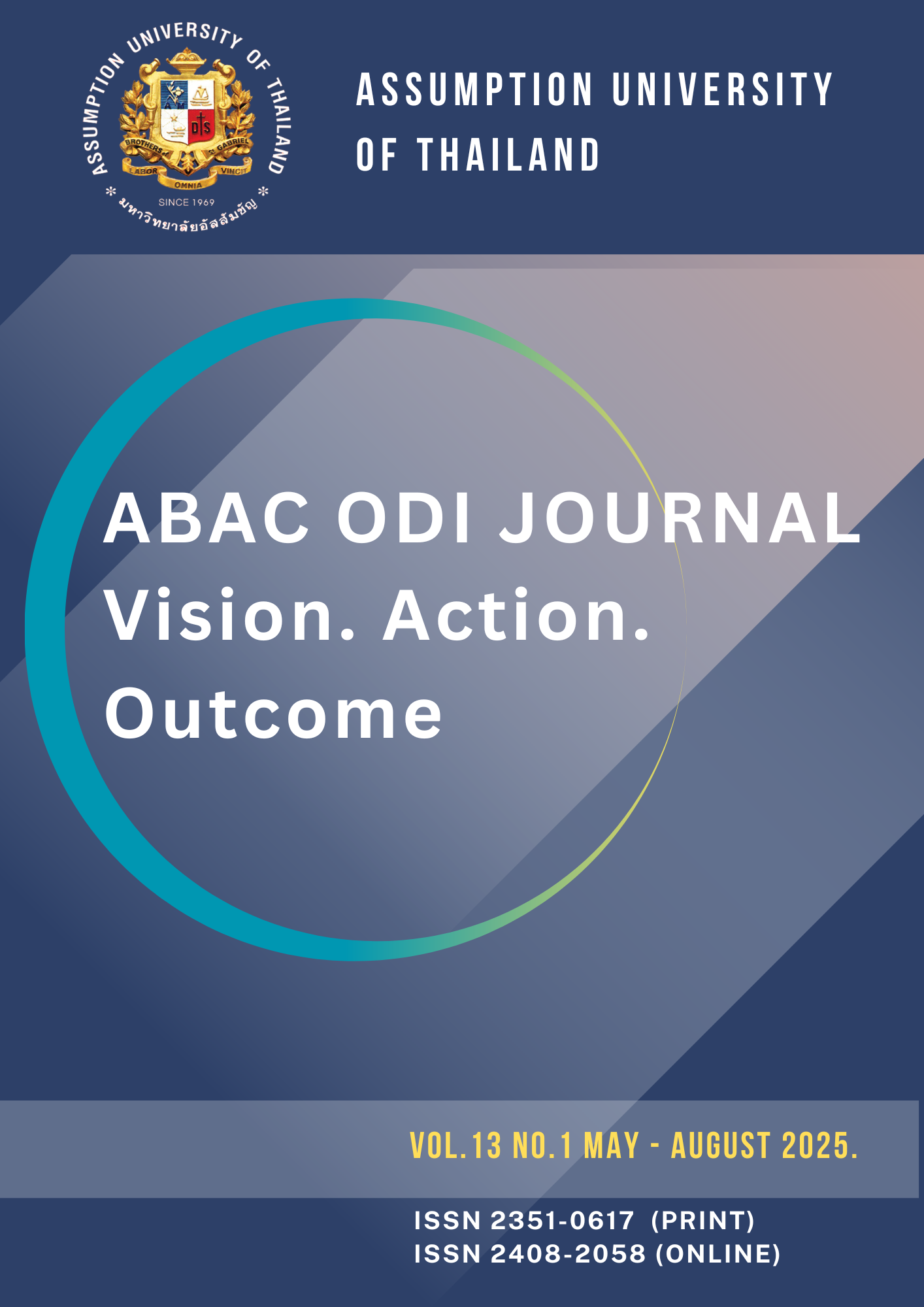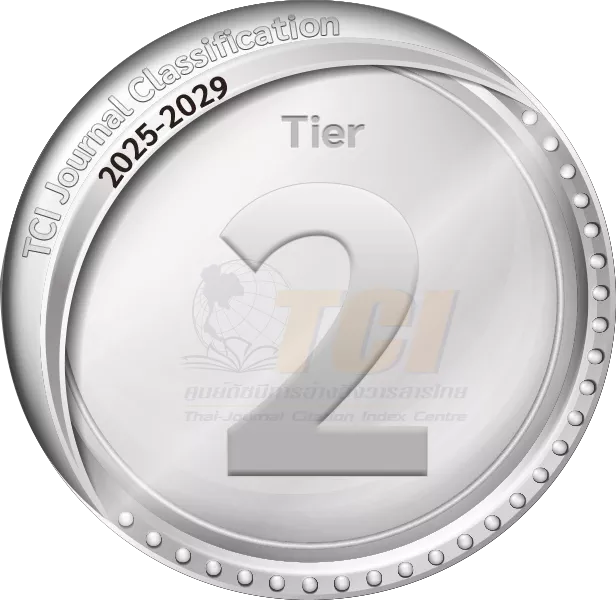Assessing Factors Impacting College Students’ Attitudes and Behavioral Intentions Toward Augmented Reality Technologies in Yibin, China
DOI:
https://doi.org/10.14456/abacodijournal.2025.29Keywords:
College Students, Augmented Reality (AR), Attitude, Behavioral Intention,TAM, UTAUTAbstract
This study assessed the factors influencing the attitudes and behavioral intentions of college students in Yibin, China, regarding the use of augmented reality (AR) technology. The research focused on students aged 18 and above who showed interest in AR technology. This study leverages three significant theoretical models(TAM, UTAUT, IDT)to enhance and refine the conceptual framework. The conceptual framework included interactivity, innovation, perceived usefulness, sense of presence, perceived ease of use, attitude, and behavioral intention. A total of 450 students from four different majors participated in the survey. The data collection process was carried out in three phases: purposive sampling, stratified random sampling, and convenience sampling. To ensure the quality of the data, experts conducted an Item-Objective Congruence (IOC) assessment of the survey items prior to data collection, followed by a pilot test with 50 participants. Through confirmatory factor analysis (CFA), the factor structure's appropriateness and the model's test were verified, demonstrating a satisfactory fit, with the following model fit indices: CMIN/dF = 2.385, GFI = 0.874, AGFI = 0.847, CFI = 0.949, TLI = 0.942, and RMSEA = 0.056. These indices confirm the reliability and validity of our constructs. Notably, perceived usefulness was identified as the most influential factor on attitude, which in turn significantly impacts behavioral intention. As technology continues to evolve, augmented reality (AR) is demonstrating extensive potential across various domains, including education, business, and entertainment. Given their role as early adopters of new technologies, college students are instrumental in driving the adoption and practical application of AR technology.
References
Agarwal, R., & Prasad, J. (1998). A Conceptual and Operational Definition of Personal Innovativeness in the Domain of Information Technology. Information Systems Research, 9(2), 204-215. https://doi.org/10.1287/isre.9.2.204
Ahn, T., Ryu, S., & Han, I. (2007). The impact of Web quality and playfulness on user acceptance of online retailing. Information & Management, 44(3), 263-275. https://doi.org/10.1016/j.im.2006.12.008
Ajzen, I. (1980). Understanding attitudes and predictiing social behavior. Englewood Cliffs. https://cir.nii.ac.jp/crid/1572543024551612928
Ali, F., Omar, R., & Amin, M. (2013). An examination of the relationships between physical environment, perceived value, image and behavioural Intentions: A SEM approach towards Malaysian resort hotels. Journal of Hotel and Tourism Management, 27(2), 9-26.
Altunel, M., & Koçak, Ö. (2017). The roles of subjective vitality, involvement, experience quality, and satisfaction in tourists’ behavioral intentions. European Journal of Tourism Research, 16, 233-251.
Armitage, C. J., & Conner, M. (2001). Efficacy of the Theory of Planned Behaviour: A meta-analytic review. British Journal of Social Psychology, 40(4), 471-499.
https://doi.org/10.1348/014466601164939
Awang, Z. (2012). Structural equation modeling using AMOS graphic. Penerbit Universiti Teknologi MARA.
Bentler, P. M. (1990). Comparative fit indexes in structural models. Psychological Bulletin, 107(2), 238-246.
Carmigniani, J., Furht, B., Anisetti, M., Ceravolo, P., Damiani, E., & Ivkovic, M. (2011). Augmented reality technologies, systems and applications. Multimedia Tools and Applications, 51(1), 341-377. https://doi.org/10.1007/s11042-010-0660-6
Castillo S, M. J., & Bigne, E. (2021). A model of adoption of AR-based self-service technologies: A two country comparison. International Journal of Retail & Distribution Management, 49(7), 875-898. https://doi.org/10.1108/IJRDM-09-2020-0380
Chen, S.-C., Liu, S.-C., Li, S.-H., & Yen, D. C. (2013). Understanding the Mediating Effects of Relationship Quality on Technology Acceptance: An Empirical Study of E-Appointment System. Journal of Medical Systems, 37(6), 9981.
https://doi.org/10.1007/s10916-013-9981-0
Cheng, P., OuYang, Z., & Liu, Y. (2019). Understanding bike sharing use over time by employing extended technology continuance theory. Transportation Research Part A: Policy and Practice, 124, 433-443. https://doi.org/10.1016/j.tra.2019.04.013
Davis, F. D., Bagozzi, R. P., & Warshaw, P. R. (1989). User Acceptance of Computer Technology: A Comparison of Two Theoretical Models. Management Science, 35(8), 982-1003. https://doi.org/10.1287/mnsc.35.8.982
de Ruyter, K., Heller, J., Hilken, T., Chylinski, M., Keeling, D. I., & Mahr, D. (2020). Seeing with the Customer’s Eye: Exploring the Challenges and Opportunities of AR Advertising. Journal of Advertising, 49(2), 109-124.
https://doi.org/10.1080/00913367.2020.1740123
Dikko, M. (2016). Establishing construct validity and reliability: Pilot testing of a qualitative interview for research in Takaful (Islamic insurance). The Qualitative Report, 21(3), 521-528.
Dogra, P., Kaushik, A. K., Kalia, P., & Kaushal, A. (2023). Influence of augmented reality on shopping behavior. Management Decision, 61(7), 2073-2098.
https://doi.org/10.1108/MD-02-2022-0136
Dwivedi, Y. K., Rana, N. P., Jeyaraj, A., Clement, M., & Williams, M. D. (2019). Re-examining the Unified Theory of Acceptance and Use of Technology (UTAUT): Towards a Revised Theoretical Model. Information Systems Frontiers, 21(3), 719-734.
https://doi.org/10.1007/s10796-017-9774-y
Fogg, B. J. (2002). Persuasive technology: Using computers to change what we think and do. Ubiquity, 2002(December), 5:2. https://doi.org/10.1145/764008.763957
Fornell, C., & Larcker, D. F. (1981). Evaluating Structural Equation Models with Unobservable Variables and Measurement Error. Journal of Marketing Research, 18(1), 39-50. https://doi.org/10.1177/002224378101800104
Gao, Q., Rau, P.-L. P., & Salvendy, G. (2009). Perception of Interactivity: Affects of Four Key Variables in Mobile Advertising. International Journal of Human–Computer Interaction, 25(6), 479-505. https://doi.org/10.1080/10447310902963936
Hoffman, D. L., & Novak, T. P. (2009). Flow Online: Lessons Learned and Future Prospects. Journal of Interactive Marketing, 23(1), 23-34.
https://doi.org/10.1016/j.intmar.2008.10.003
Huang, T.-L., & Hsu Liu, F. (2014). Formation of augmented-reality interactive technology’s persuasive effects from the perspective of experiential value. Internet Research, 24(1), 82-109. https://doi.org/10.1108/IntR-07-2012-0133
Jang, S., & Feng, R. (2007). Temporal destination revisit intention: The effects of novelty seeking and satisfaction. Tourism Management, 28(2), 580-590.
https://doi.org/10.1016/j.tourman.2006.04.024
Javornik, A. (2014). [Poster] classifications of augmented reality uses in marketing. 2014 IEEE International Symposium on Mixed and Augmented Reality - Media, Art, Social Science, Humanities and Design (ISMAR-MASH’D), 67-68.
https://doi.org/10.1109/ISMAR-AMH.2014.6935441
Javornik, A. (2016). ‘It’s an illusion, but it looks real!’ Consumer affective, cognitive and behavioural responses to augmented reality applications. Journal of Marketing Management, 32(9-10), 987-1011. https://doi.org/10.1080/0267257X.2016.1174726
Jayaswal, P., & Parida, B. (2023). The role of augmented reality in redefining e-tailing: A review and research agenda. Journal of Business Research, 160, 113765. https://doi.org/10.1016/j.jbusres.2023.113765
Johannesson, P., & Karlsson, J. (2023). The early stages of extended reality: An analysis of the opportunities and challenges faced by early stage businesses within the extended reality (XR) industry. Spring.
https://www.diva-portal.org/smash/record.jsf?pid=diva2:1798250
Kim, J., & Forsythe, S. (2008). Adoption of Virtual Try-on technology for online apparel shopping. Journal of Interactive Marketing, 22(2), 45-59.
https://doi.org/10.1002/dir.20113
Kim, J.-H., Kim, M., Park, M., & Yoo, J. (2021). How interactivity and vividness influence consumer virtual reality shopping experience: The mediating role of telepresence. Journal of Research in Interactive Marketing, 15(3), 502-525.
https://doi.org/10.1108/JRIM-07-2020-0148
Kim, J.-H., Kim, M., Park, M., & Yoo, J. (2023). Immersive interactive technologies and virtual shopping experiences: Differences in consumer perceptions between augmented reality (AR) and virtual reality (VR). Telematics and Informatics, 77, 101936.
https://doi.org/10.1016/j.tele.2022.101936
Lavoye, V., Mero, J., & Tarkiainen, A. (2021). Consumer behavior with augmented reality in retail: A review and research agenda. The International Review of Retail, Distribution and Consumer Research, 31(3), 299-329.
https://doi.org/10.1080/09593969.2021.1901765
Li, T., & Meshkova, Z. (2013). Examining the impact of rich media on consumer willingness to pay in online stores. Electronic Commerce Research and Applications, 12(6), 449-461. https://doi.org/10.1016/j.elerap.2013.07.001
Liu, Y. (2010). Social Media Tools as a Learning Resource. Journal of Educational Technology Development and Exchange, 3, 101-114.
Lombard, M., & Ditton, T. (1997). At the Heart of It All: The Concept of Presence. Journal of Computer-Mediated Communication, 3(2), JCMC321.
https://doi.org/10.1111/j.1083-6101.1997.tb00072.x
Lucas, H., Carbajo, R., Machiba, T., Zhukov, E., & Cabeza, L. F. (2021). Improving Public Attitude towards Renewable Energy. Energies, 14(15), 15.
https://doi.org/10.3390/en14154521
Lutz, R. J. (1985). Affective and cognitive antecedents of attitude toward the ad: A conceptual framework. Psychological Processes and Advertising Effects, 45-64.
Marangunić, N., & Granić, A. (2015). Technology acceptance model: A literature review from 1986 to 2013. Universal Access in the Information Society, 14(1), 81-95.
https://doi.org/10.1007/s10209-014-0348-1
Pantano, E., Rese, A., & Baier, D. (2017). Enhancing the online decision-making process by using augmented reality: A two country comparison of youth markets. Journal of Retailing and Consumer Services, 38, 81-95.
https://doi.org/10.1016/j.jretconser.2017.05.011
Park, M., & Yoo, J. (2020). Effects of perceived interactivity of augmented reality on consumer responses: A mental imagery perspective. Journal of Retailing and Consumer Services, 52, 101912. https://doi.org/10.1016/j.jretconser.2019.101912
Pedroso, R., Zanetello, L., Guimarães, L., Pettenon, M., Gonçalves, V., Scherer, J., Kessler, F., & Pechansky, F. (2016). Confirmatory factor analysis (CFA) of the crack use relapse scale (CURS). Archives of Clinical Psychiatry (São Paulo), 43(3), 37-40.
Poretski, L., Arazy, O., Lanir, J., Shahar, S., & Nov, O. (2019). Virtual Objects in the Physical World: Relatedness and Psychological Ownership in Augmented Reality. Proceedings of the 2019 CHI Conference on Human Factors in Computing Systems, 1-13. https://doi.org/10.1145/3290605.3300921
Portalés, C., Lerma, J. L., & Navarro, S. (2010). Augmented reality and photogrammetry: A synergy to visualize physical and virtual city environments. ISPRS Journal of Photogrammetry and Remote Sensing, 65(1), 134-142.
Rauschnabel, P. A., Felix, R., Hinsch, C., Shahab, H., & Alt, F. (2022). What is XR? Towards a Framework for Augmented and Virtual Reality. Computers in Human Behavior, 133, 107289. https://doi.org/10.1016/j.chb.2022.107289
Saavedra, Á., Chocarro, R., Cortiñas, M., & Rubio, N. (2023). Impact of process and outcome quality on intention for continued use of voice assistants. Spanish Journal of Marketing - ESIC, ahead-of-print(ahead-of-print). https://doi.org/10.1108/SJME-12-2022-0251
Samini, A., Palmerius, K. L., & Ljung, P. (2021). A review of current, complete augmented reality solutions. 2021 International Conference on Cyberworlds (CW), 49-56. https://ieeexplore.ieee.org/abstract/document/9599344/
Schaufeli, W. B., Salanova, M., González-romá, V., & Bakker, A. B. (2002). The Measurement of Engagement and Burnout: A Two Sample Confirmatory Factor Analytic Approach. Journal of Happiness Studies, 3(1), 71-92. https://doi.org/10.1023/A:1015630930326
Sharma, G. P., Verma, R. C., & Pathare, P. (2005). Mathematical modeling of infrared radiation thin layer drying of onion slices. Journal of Food Engineering, 71(3), 282-286.
Sica, C., & Ghisi, M. (2007). The Italian versions of the Beck Anxiety Inventory and the Beck Depression Inventory-II: Psychometric properties and discriminant power. Leading-Edge Psychological Tests and Testing Research, 27-50.
Smink, A. R., Frowijn, S., van Reijmersdal, E. A., van Noort, G., & Neijens, P. C. (2019). Try online before you buy: How does shopping with augmented reality affect brand responses and personal data disclosure. Electronic Commerce Research and Applications, 35, 100854. https://doi.org/10.1016/j.elerap.2019.100854
Srivastava, A., Dasgupta, S. A., Ray, A., Bala, P. K., & Chakraborty, S. (2021). Relationships between the “Big Five” personality types and consumer attitudes in Indian students toward augmented reality advertising. Aslib Journal of Information Management, 73(6), 967-991.
Statista. (2024, May 14). AR hardware B2C market size 2022-2029. Statista. https://www.statista.com/forecasts/1337265/ar-hardware-b2c-market-revenue-worldwide
Suhartanto, D. (2019). Predicting behavioural intention toward Islamic bank: A multi-group analysis approach. Journal of Islamic Marketing, 10(4), 1091-1103.
https://doi.org/10.1108/JIMA-02-2018-0041
Taherdoost, H. (2017). Determining sample size; how to calculate survey sample size. International Journal of Economics and Management Systems, 2, 237-239.
https://papers.ssrn.com/sol3/papers.cfm?abstract_id=3224205
Van Esch, P., Arli, D., Gheshlaghi, M. H., Andonopoulos, V., von der Heidt, T., & Northey, G. (2019). Anthropomorphism and augmented reality in the retail environment. Journal of Retailing and Consumer Services, 49, 35-42.
https://doi.org/10.1016/j.jretconser.2019.03.002
van Noort, G., Voorveld, H. A. M., & van Reijmersdal, E. A. (2012). Interactivity in Brand Web Sites: Cognitive, Affective, and Behavioral Responses Explained by Consumers’ Online Flow Experience. Journal of Interactive Marketing, 26(4), 223-234.
https://doi.org/10.1016/j.intmar.2011.11.002
Vashisht, D., Mohan, H. S., & Chauhan, A. (2020). In-game advertising: The role of newness congruence and interactivity. Spanish Journal of Marketing - ESIC, 24(2), 213-230. https://doi.org/10.1108/SJME-02-2019-0012
Verhagen, T., Vonkeman, C., Feldberg, F., & Verhagen, P. (2014). Present it like it is here: Creating local presence to improve online product experiences. Computers in Human Behavior, 39, 270-280.
Wilson, N., Keni, K., & Tan, P. H. P. (2021). The role of perceived usefulness and perceived ease-of-use toward satisfaction and trust which influence computer consumers’ loyalty in China. Gadjah Mada International Journal of Business, 23(3), 262-294.
https://search.informit.org/doi/abs/10.3316/informit.147511565887487
Wu, J.-H., & Wang, Y.-M. (2006). Measuring KMS success: A respecification of the DeLone and McLean’s model. Information & Management, 43(6), 728-739.
Yim, M. Y.-C., Chu, S.-C., & Sauer, P. L. (2017). Is Augmented Reality Technology an Effective Tool for E-commerce? An Interactivity and Vividness Perspective. Journal of Interactive Marketing, 39(1), 89-103. https://doi.org/10.1016/j.intmar.2017.04.001
Zarmpou, T., Saprikis, V., Markos, A., & Vlachopoulou, M. (2012). Modeling users’ acceptance of mobile services. Electronic Commerce Research, 12(2), 225-248.




